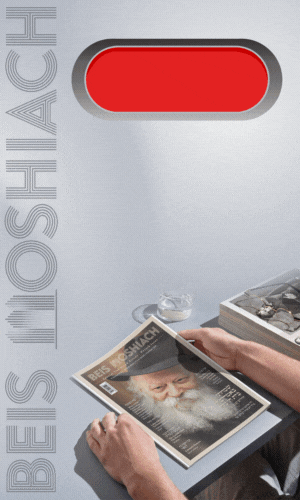Op-Ed: Is It Time To Talk About Tznius and Beards?
As we begin preparing for Rosh Hashana, the time for reaccepting upon ourselves the kingship of Hashem, it is appropriate to speak about two very important and sensitive topics: Tznius and Beards • By Rabbi Gershon Avtzon • Full Article
By Rabbi Gershon Avtzon, Cincinnati, Ohio
As we begin preparing for Rosh Hashana, the time for reaccepting upon ourselves the kingship of Hashem, it is appropriate to speak about two very important and sensitive topics: Tznius and Beards. Being open and transparent: When I told a few of my close friends and family members of my Hakhel Hachlata/resolution, to write monthly Op-Eds on Chinuch related issues, I was warned that there are certain topics that one must stay away from and they automatically turn off the reader as they already have formed a strong emotional opinion on the matter. The two main topics were “Tznius” for girls and women and “beards” for boys and men.
Throughout the year I have listened to this sage advice but as we are finishing this special Hakhel year, I feel it appropriate to share an important Chinuch perspective on the above-mentioned topics. To be clear: I am not: 1) writing to vent my personal frustration of the lowering standards in our communities 2) giving a halacha (or mussar) shiur 3) pointing fingers at individuals or institutions. I am writing to share a Chinuch approach to these, and other important halachos and minhagim, that our children may find initially burdensome or restricting.
In my twenty years in Chinuch, I have observed the following pattern. There are certain families that have (generally) managed to instill higher-standards in their children in specific areas , even if the children (or families from where they come from) were “regular” in their general standards of Chassidhkeit and Yiras Shamayim. These standards were adhered to even though they were difficult and also demanded a certain level of sacrifice.
I will share two examples: 1) There is one family that is very careful about eating only “split-chicken” and members of this family would have to forgo many meals in Yeshiva that served non-split chicken. 2) I have seen descendants of the “Shalah Hakadosh” that have given up on eating meals where “turkey” was served.
[ There are many examples that I can bring. I bring examples of eating, as this area is very important to a Mesivta-age bochur. Many are away from home and this is the only food that they get to eat.]
At the beginning I wondered how these families were able to instill these values into their children to the extent that even when the children leave their parents sight and care they hold on to these (seemingly) “chumros”.
After observing, and asking the talmidim themselves, the picture became crystal clear: These stringencies were presented to, and instilled in, the children with a strong sense of honor and pride from the very beginning. They were explained that they are from a special family and these stringencies are a badge of honor for their special family. Presented in such a way, the children in these families wanted to keep wearing, and identifying with, this special badge of honor.
In practical terms: As parents and machanchim, we must be aware that there are certain values that we want to instill in our children that will make them look and act different from those which are around them. The way to do that is, not by creating the illusion that it is easy – rather, by constantly (and from a young age) speaking about how special we (as Yidden and Chassidim) are and the pride of wearing these badges of honor.
I once spoke to a group of girls that had difficulties with Tznius. I presented the following scenario: Imagine you walked into the Beis Hamikdash and saw all the Kohanim wearing four garments and one Kohein wearing eight. Would you feel bad for the one that is stuck wearing eight (as opposed to four)? Do you think the person wearing eight garments feels self-conscious or restricted by his extra external garments? They all looked at me and answered: “Of course not! The one wearing eight is the Kohein Gadol and people would risk their lives (knowing that they would have to enter the Kodesh Kadashim) just for the honor of being a Kohein Gadol!
I smiled and looked at each of those girls and explained to them that as a “Bas Yisroel and Bas Chabad”, they are also a Kohein Gadol and the “extra garments” (tznius) that Hashem wants them to wear is an expression of their unique status and position in this world. It had a tremendous effect on those girls.
[ On the topic of Tznius, and close to Tishrei,I would like to bring up the following question that I have been wondering: If you daven in 770 on Yom Tov, you will observe the pre (and post) Birchas Kohanim rush in which many frum and Chassidishe couples meet up right outside 770 to ensure that their kids are under the Tallis for Brichas Kohanim. It creates a very sticky tznius situation for all those people (especially bochurim) who are entering or exiting the shul. Is it the right thing and appropriate? I leave the question to each couple to think about and discuss with their Rav.]
The same approach applies to instilling in our boys the importance and pride in always having a full beard: Some have taken the approach to start teaching the boys the many poskim that speak of the severity of the issur of trimming or shaving. While I fully agree that boys should be aware of the Halachik severity and stringency of this important issue, and that having a full-beard is not a chumara rather a din, this approach should be secondary. The primary approach needs to be speaking about the beauty of being a yid and Chassid – and looking like one – and how Chassidim were literally Moser nefesh to have a full beard.
Many years ago, in 5758, I spent a shabbas at the Chabad@Flamingo (Toronto) which is directed by Rabbi and Mrs. Mendel Kaplan, It was a frosty shabbas morning and we walked to Chabad Gate (half-hour) to go to the Mikva before Davening. During our walk, Rabbi Mendel Kaplan shared the following: Some of his Balebatim ask him why he walks such a distance – in the freezing weather – just to go to the Mikva. He does not answer them what is says is sefarim about Mikva, rather answers the following: “If chassidim in Russia broke ice to go to the Mikva, I could and should walk the half hour in a warm coat to go to a nice and warm indoor Mikvah.”
It is only after we say “Ata Beachrtanu mekol Ha’amim – Hashem has chosen us from all the nations” that we continue to say “Vikitashtanu B’mitzvosecha – you sanctified us with your Mitzvos”. Instilling a true Geon Yaakov in being a Yid and chassid of the Rebbe – and then explaining what badges of honor and appropriate actions and behaviors comes along with that – is the only way that the values we work so hard to engrain and instill in our children and talmidim will be long lasting and meaningful.
Wishing everyone a Kesiva Vachasima Tova, much Chassidishe Nachas from all your children, and Moshiach now!
If you have comments, questions or ideas, please write in the comment section below or email me directly at [email protected]
286
Join ChabadInfo's News Roundup and alerts for the HOTTEST Chabad news and updates!











































